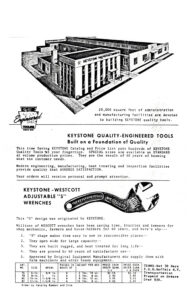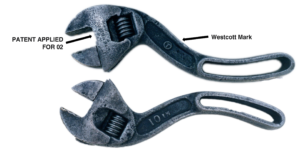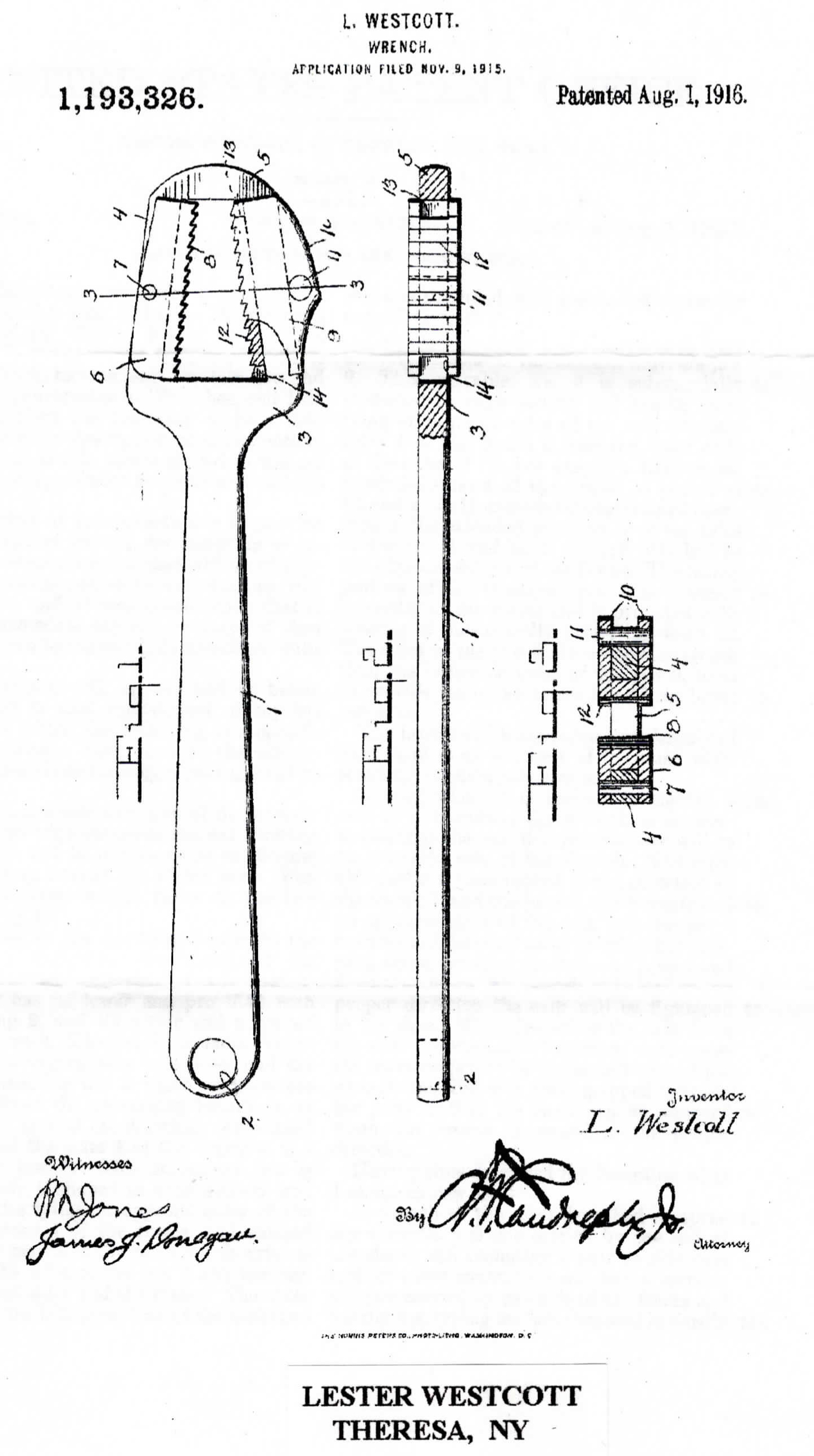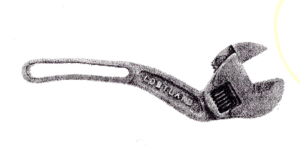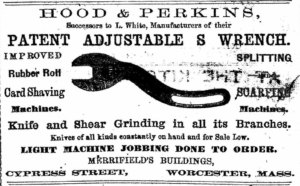
This 12-inch No. 82 Westcott Wrench is from the toolbox of William Wescott Smith (1916-2008), a metalsmith who plied his trade in Wakefield, Rhode Island and the blacksmith at the South County Museum in nearby Narragansett. The wrench originally belonged to his grandfather, Wescott Smith (1856-1933), who was a compressor engineer for the Union Railroad, then manager of Gov. William Spague’s Canonchet Farm and finally the Supervisor of Roads in Narragansett, three good reasons to have a Westcott Wrench at the ready.
The Westcott Wrench is an adjustable spanner with a distinctive S-shaped handle that was produced by the Keystone Manufacturing Company in a wide range of sizes and designs, including nut wrenches, pipe wrenches and “automobile wrenches.” Keystone began selling Westcott Wrenches in 1901 and trademarked the brand in 1907. Page 2 of Keystone’s 1969 catalog claimed:
“Millions of WESTCOTT wrenches have been saving time, knuckles and tempers for shop mechanics, farmers and house-holders for 60 years, and here’s why—
1. “S” shape makes them easy to use in inaccessible places–
2. They open wide for large capacity–
3. They are built rugged, and heat treated for long life-
4. They are proved by 60 years of satisfactory use –
5. Approved by Original Equipment Manufacturers [OEMs] who supply them with farm machinery and other heavy equipment.”
Among those OEMs was Henry Ford, who beginning in 1917 included a Westcott Wrench in the toolbox for the new Fordson tractors. The wrench remained standard equipment for tractors and other heavy equipment built by the Ford Motor Company (U.S.) until 1928 and by Ford Motor Company Ltd. (U.K.) until 1964. The wrench was also included in Ford motor cars in the ’20s.
In the 1990s, then Westcott Society Historian Betty Acker was on a singular quest to acquire each variety of the wrench and discover its origin.
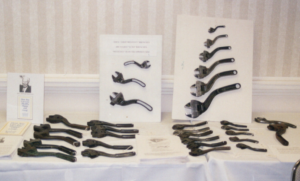
Table-top display of Westcott wrenches at the Biennial Westcott Society Reunion in Colorado Springs, Colorado in 2000.
Betty collected more than two dozen models of the Westcott Wrench and displayed them at the 2000 Westcott Society biennial gathering in Colorado Springs. Nine of these wrenches are in a permanent display at the Warwick (R.I.) Historical Society. They range in size from the hefty 14-inch No. 84 to the petite 4-inch No. 74, a rare find. Six of the wenches have solid handles with “WESTCOTT” and “THE KEYSTONE MFG CO” marked in raised lettering on one side, as shown in the photo at the top of the page. The other three have cutouts on the lower handle and the solid upper handle is marked “WESTCOTT” in raise lettering on one side and “AUTO WRENCH” on the other. These three were made for OEMs. All nine wrenches were manufactured by Keystone.
For an article in the January-April 1999 Westcott Family Quarterly (and the display at the reunion), Betty copied the Keystone catalog description of the wrench and wrote, “I have been unable to locate any more definite information other than the above about the ‘Westcott wrench.’ Does anyone know more of the history of this wrench?” Based on the 1969 Keystone catalog, Betty placed the invention of the wrench about 1909. From her notes, correspondence, and E-Bay invoices in the archive, there appears to be three candidates for the honors. Spoiler: None of them invented the Westcott Wrench, but this trio of innovators deserves our notice.
Bey Westcott, Soledad, California
One of the first responses to Betty’s call in the Westcott Family Quarterly came from Bob Fulton who wrote, “Sorry to dispute the Keystone Co. as to the origin of the design but —–” and then put forth his great uncle Bey Westcott as the inventor of the wrench. “I have in my possession one of the handmade originals by Bey made in his blacksmith shop in Soledad.”
Bey Westcott was the son of Varnum and Helen Westcott of North-to-Alaska fame and a descendant of Stukely and Juliana Westcott in ninth generation (Bey9 Westcott, Varnum8, David7, Ephraim6, Oliver5, George4, Jeremiah Jr3, Jeremiah2, Stukely1). In 1896, the Salinas Californian described Bey as a “well known rancher and threshing-machine man and [he] is one of the substantial business men of the section.” In the 1926 Salinas City Directory, Bey is at the Monterey Machine Shop. A threshing-machine man with a blacksmith shop – sounds like a good candidate.
Bob sent pictures of his uncle’s prototype. The 10-inch S-handle wrench has an open lower handle, a circular mark identifying Bey’s shop on the upper handle and “PATENT APPLIED FOR 02” stamped just below the jaw. However, a search of the Directory of American Tool and Machinery Parts database did not show a patent for Bey’s wrench. It may be that the patent application was not successful as the S-handle was common adaptation for hand tools in the 19th century and S-handle nut and pipe wrenches were being manufactured as early as 1889. For example, in his American Wrench Makers 1830-1930, Kenneth Cope writes, “In 1894, the company [Bemis & Call Hardware and Tool Co.] introduced an adjustable S wrench. An improved version, with pipe jaws, was introduced in 1898 and a double ended version in 1909.”
Lester Westcott, Theresa, New York
Another candidate in the archive for the inventor of the Westcott Wrench – and a long shot – is Lester Westcott (1854-1933) of Theresa, New York, who secured a patent in 1916 for an adjustable wrench (with a straight shank) for removing horseshoe cobbs.
Lester was born in Theresa, the son of Jason and Ann Eliza (Snell) Westcott; he was a descendant in the ninth generation of Stukely and Juliana Westcott (Lester9 Westcott, Jason8, Nathan7, Caleb6, Gardner5, Caleb4, Josiah3, Jeremiah2, Stukely1).
In the 1880 Federal Census, Lester Westcott’s occupation is reported to be machinist, but from 1900 forward his occupation is blacksmith. (Good hint right there as, “The work does not begin until the blacksmith makes the tools.”) Lester was doing what other innovators were doing: building on the 19th century American technical advances in tool making. Lester did not file any other patent applications, and there is no need for an S-handle in horseshoeing, but he deserves a spot on the medal stand for Westcott wrench makers.
George Nelson Westcott, Homer, New York
As Betty Acker scoured E-Bay for Westcott wrenches, she received an offer of a 14-inch adjustable pipe wrench with an S-handle made by Cortland Forging Company, with this description of the early Westcott wrench: “The Wescott name is marked just beneath the jaw, where it is imprinted ‘G. N. Wescott’, beneath that in larger, block letters, it says ‘HOMER, N.Y.’ The back side of the wrench says ’14 in Pipe’ and the front side, as you can see from the photograph, says ‘Cortland.'” A company variously known as Cortland Forging Co., Cortland Wrench, Wescott Wrench, and Westcott Wrench began manufacturing in the 1880s and popularized the S-handle adjustable pipe and nut wrenches that became The Westcott Wrench.
George Nelson Westcott was born on April 29, 1836 in Cortland County, New York, the third child of Owen and Emily (Stewart) Westcott; he was a descendant of Stukely and Juliana Westcott in the eighth generation (George Nelson8 Westcott, Owen7, Gorton6, Reuben5, Amos4, William3, Jeremiah2, Stukely1). He married Julia Ann Gutches on June 15, 1858. In some census records and city directories, George and Emily’s name is spelled Wescott.
In 1888, Manning’s Cortland, Homer and McGraw (Cortland County, New York) Directory listed George as a resident of Homer, New York: “Wescott Geo. N. mfg Wescott wrench s main h do” and in the Homer Business Directory under the heading “Wrench Manu’f’r“: “Wescott, Geo. N., S. Main.” In February 1892, The Iron Age journal reported: “The Wescott Wrench Company, successor to Cortland Wrench Company, Homer, N. Y., report that sales are constantly increasing, and that they are endeavoring in every way to add the quality and durability of their wrenches, both plain and pipe.” Apparently, the company was successful in producing quality wrenches in quantity as it attracted the attention of business interests in Buffalo, who acquired manufacturing rights from Wescott Wrench, moved the operation to Buffalo and began marketing “WESTCOTT” wrenches in 1901. In the 1892 state census and the 1900 Federal census, George N. Wescott was going by George Nelson Westcott.
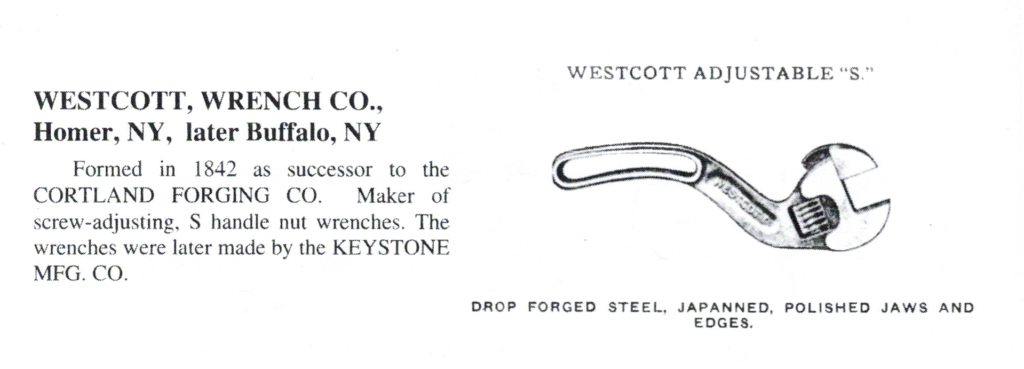
Entry for Westcott Wrench Company in Kenneth Cope’s American Wrench Makers 1830-1930. (Note that the date 1842 should be 1892.)
By 1901 the Keystone Manufacturing Company catalog was offering its WESTCOTT wrench. The company applied to the U.S. Patent Office to trademark WESTCOTT for its line of S-handle adjustable wrenches, affirming that “the trade-mark has been continuously used in the business of said corporation and in the business of its predecessor George N. Westcott, since March 1, 1894.” The trademark was registered on May 21, 1907. Interestingly the company did not secure a patent for the wrench design.
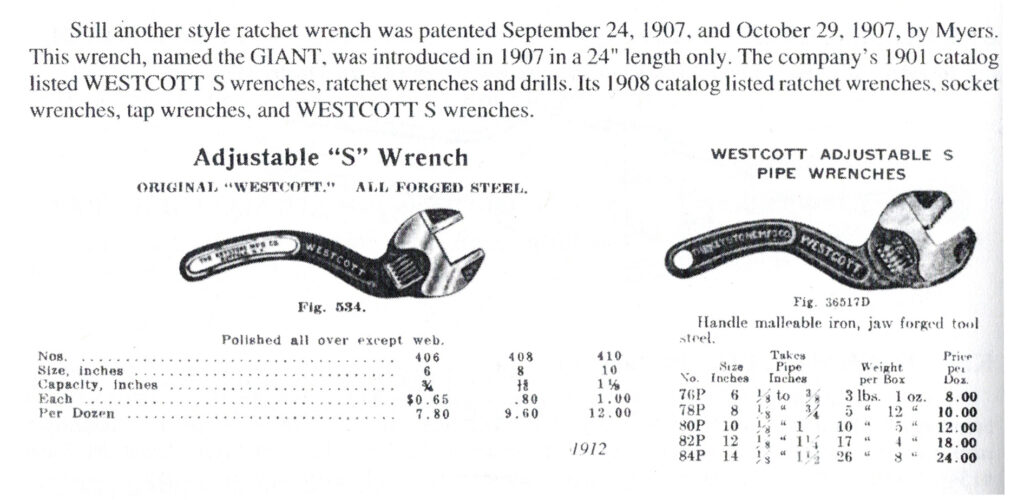
Entry in Cope’s American Wrench Makers 1830-1939 for Keystone Manufacturing Co and its WESTCOTT Adjustable S nut wrench (left) and pipe wrench. Note that even with the trademark registration, the 1912 catalog asserts the wrench is the “Original ‘Westcott,'” an indication that Westcott had become the common name for a product made by multiple companies.
Most of the evidence points to George Nelson Westcott as the source of the tradename, but neither George nor either of the other Westcotts who designed and made wrenches was the inventor. Adjustable wrenches with S-handles were in the market decades earlier. One example is in a Hood & Perkins ad in a Worcester, Massachusetts city directory in 1866 for a “PATENT ADJUSTABLE S WRENCH.” However, the patent, secured by Edward Worcester and sold to Hood & Perkins, was for the improvements to the adjustment mechanism and not for the handle design.
That’s the case so far. New evidence and leads are always welcome at dsmithmark@cox.net. David Wescott Smith, April 30, 2021.
Sources:
Ancestry.com and FamilySearch.com for vital records and U.S. City Directories.
Kenneth L. Cope, American Wrench Makers 1830-1930, 2nd edition, 2002
Directory of American Tool and Machinery Parts database
Edna Lewis, The Westcott Family Tree, 1999 (index numbers 917, 1070, 1360)
The Garage Journal Board
Hathi Trust Digital Library: The Iron Age journal
Manning’s Cortland, Homer and McGraw (Cortland County, New York)Directory
Papaswrench, Tool Talk Bulletin Board

